 Wooster, Ohio– This afternoon three industrious summer research students and I took advantage of the brilliant weather to drive 30 minutes north of town to Lodi Community Park in Medina County, Ohio. We wanted to take a break from lab work and writing to explore for interesting rocks and fossils. I also wanted to revisit the outcrops because of some new interest in the fossils by colleagues. I was last at this site eleven years ago with a Sedimentology & Stratigraphy class.
Wooster, Ohio– This afternoon three industrious summer research students and I took advantage of the brilliant weather to drive 30 minutes north of town to Lodi Community Park in Medina County, Ohio. We wanted to take a break from lab work and writing to explore for interesting rocks and fossils. I also wanted to revisit the outcrops because of some new interest in the fossils by colleagues. I was last at this site eleven years ago with a Sedimentology & Stratigraphy class.
Lodi Community Park has a narrow valley through which flows the East Fork of the Black River. (The depth of the valley indicates it was originally cut by a much larger river in the waning days of the Pleistocene ice sheets.) Along the cutbanks of the river are exposures of the Meadville Shale, a member of the Cuyahoga Formation. It is Lower Carboniferous (Mississippian) of the Kinderhookian Stage. The stream bed contains rocks derived from the cliffs on each side, along with the occasional glacial erratic.
 Three of our ace summer research students went with me to Lodi for this short trip. From the left, Peter Rothstein, Lauren Segura, and Evie Sanford. Peter and Evie are currently working on diatoms and sponges in Brown’s Lake, and Lauren is in the Wooster Tree-Ring Lab this summer. Behind them is an outcrop of the Meadville Shale, which here consists of poorly-resistant gray shale at the base and layers of micaceous quartzose siltstones that are more resistant. The wooden pole in the background, by the way, is a Jacob’s Staff used to measure stratigraphic columns. Each interval is 10 cm. I painted this staff when I was a new professor because I couldn’t find any metric versions in the United States!
Three of our ace summer research students went with me to Lodi for this short trip. From the left, Peter Rothstein, Lauren Segura, and Evie Sanford. Peter and Evie are currently working on diatoms and sponges in Brown’s Lake, and Lauren is in the Wooster Tree-Ring Lab this summer. Behind them is an outcrop of the Meadville Shale, which here consists of poorly-resistant gray shale at the base and layers of micaceous quartzose siltstones that are more resistant. The wooden pole in the background, by the way, is a Jacob’s Staff used to measure stratigraphic columns. Each interval is 10 cm. I painted this staff when I was a new professor because I couldn’t find any metric versions in the United States!
 Evie is here scanning the stream bed for fossils and interesting rocks. (Thank you again for driving, Evie!)
Evie is here scanning the stream bed for fossils and interesting rocks. (Thank you again for driving, Evie!)
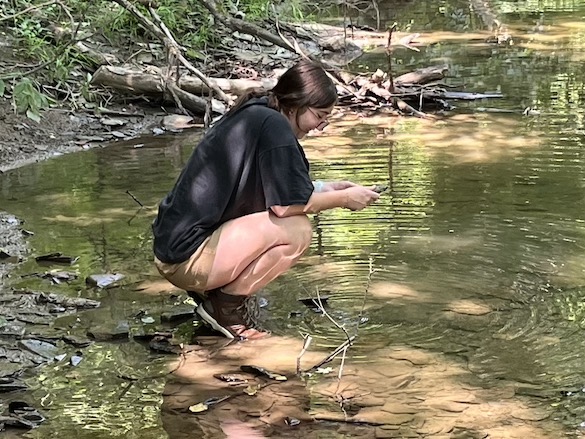 Lauren was almost always in the water when I looked.
Lauren was almost always in the water when I looked.
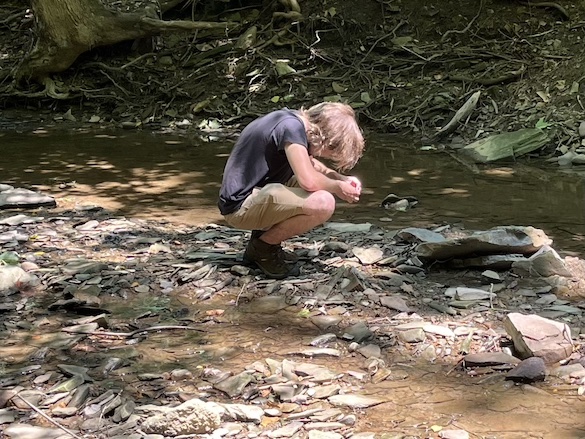 Peter was very intent in his rock-scanning. All three students made interesting finds.
Peter was very intent in his rock-scanning. All three students made interesting finds.
 This is a typical siltstone from the Meadville Shale at Lodi. It is full of branching bryozoan colonies (zoaria).
This is a typical siltstone from the Meadville Shale at Lodi. It is full of branching bryozoan colonies (zoaria).
 The underside of this siltstone slab shows numerous trace fossils. Their preservation is termed convex hyporelief.
The underside of this siltstone slab shows numerous trace fossils. Their preservation is termed convex hyporelief.
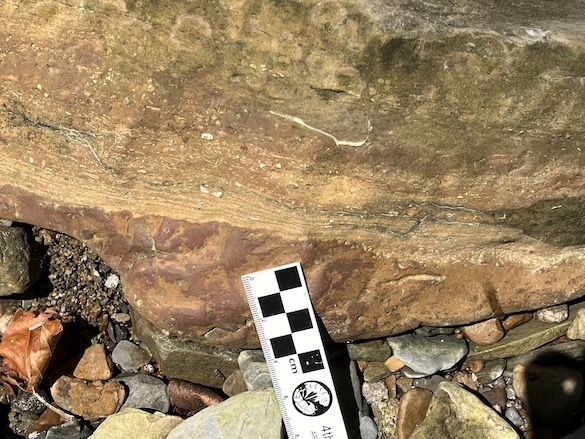 Siderite beds and concretions are common in these Lodi exposures. In this loose boulder we can see the red-brown siderite with trace fossils at the base overlain by thin beds of fine calcareous fossil debris.
Siderite beds and concretions are common in these Lodi exposures. In this loose boulder we can see the red-brown siderite with trace fossils at the base overlain by thin beds of fine calcareous fossil debris.
 This is an internal mold of a productid brachiopod. It has just a little bit of original calcite remaining from the shell. The arrow indicates hollow spines, which are characteristic of productids. It is rare to have them preserved since they are very fragile. The scale is in millimeters.
This is an internal mold of a productid brachiopod. It has just a little bit of original calcite remaining from the shell. The arrow indicates hollow spines, which are characteristic of productids. It is rare to have them preserved since they are very fragile. The scale is in millimeters.
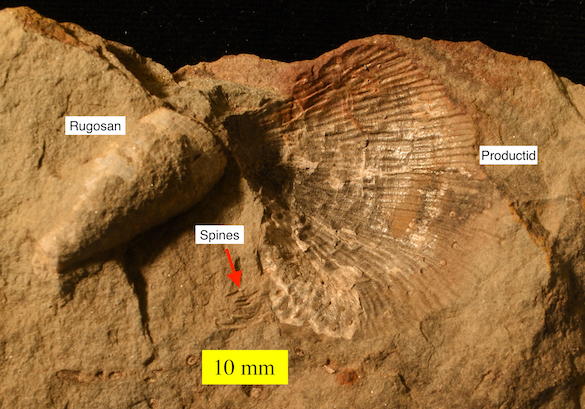 There were a few small solitary rugose coral skeletons with their original calcite. On the right is another productid brachiopod, this time as an external mold with some original calcite remaining. Some spines are visible.
There were a few small solitary rugose coral skeletons with their original calcite. On the right is another productid brachiopod, this time as an external mold with some original calcite remaining. Some spines are visible.
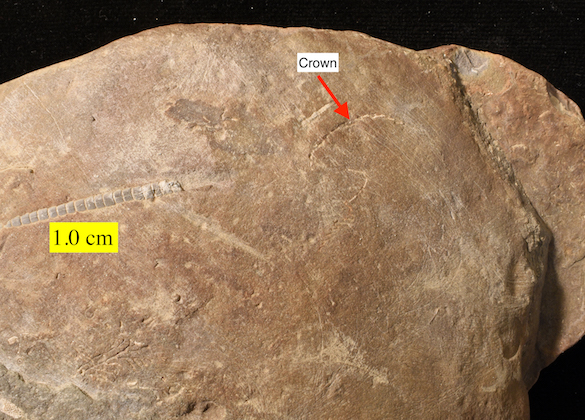 This could have been the specimen of the day but for the vagaries of preservation. This is a siderite concretion with a nearly complete crinoid. Its articulated stem (column) is easy to see on the left above the scale bar. On the right are the remnants of what would have been an entire crown with multiple feeding arms. Unfortunately this crown is eroded into a vague cross-section. It is preserved in the same manner as this contemporary specimen described in this blog.
This could have been the specimen of the day but for the vagaries of preservation. This is a siderite concretion with a nearly complete crinoid. Its articulated stem (column) is easy to see on the left above the scale bar. On the right are the remnants of what would have been an entire crown with multiple feeding arms. Unfortunately this crown is eroded into a vague cross-section. It is preserved in the same manner as this contemporary specimen described in this blog.
 This post gives me a chance to mention how this Lodi fossil locality began my career as a paleontologist. The fossil above, shown as a reversed stereo-pair, is an external mold of a trilobite cephalon. It was found in 1977 by College of Wooster student Mary Beidler. I was also a Wooster student at the time, so Mary gave it to me to identify. I was thrilled because Carboniferous trilobites are uncommon. I could, though, only classify it to the genus Brachymetopus. Turns out it was a new species, which I named in a short 1979 paper as Brachymetopus nodosus. This was my first publication. Thank you again, Mary!
This post gives me a chance to mention how this Lodi fossil locality began my career as a paleontologist. The fossil above, shown as a reversed stereo-pair, is an external mold of a trilobite cephalon. It was found in 1977 by College of Wooster student Mary Beidler. I was also a Wooster student at the time, so Mary gave it to me to identify. I was thrilled because Carboniferous trilobites are uncommon. I could, though, only classify it to the genus Brachymetopus. Turns out it was a new species, which I named in a short 1979 paper as Brachymetopus nodosus. This was my first publication. Thank you again, Mary!
 There were some big spiders under the rocks! (Photo by Evie.)
There were some big spiders under the rocks! (Photo by Evie.)
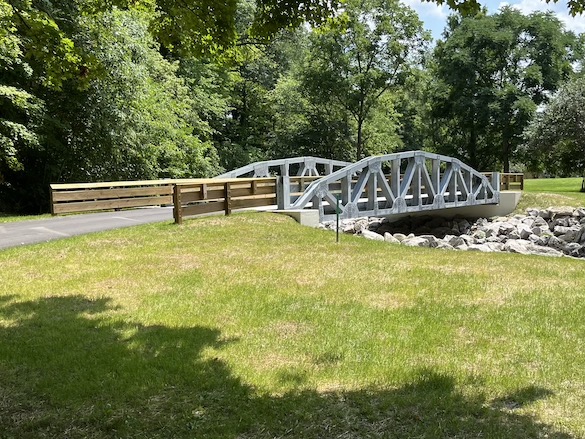 Another change since my last visit — a fancy new bridge over the stream! Back in the day it was a low concrete weir that flooded quickly, sometimes trapping people in the park. This nice bridge was opened just a couple of months ago.
Another change since my last visit — a fancy new bridge over the stream! Back in the day it was a low concrete weir that flooded quickly, sometimes trapping people in the park. This nice bridge was opened just a couple of months ago.
Thanks again to Peter, Lauren and Evie for a great afternoon of field geology!
Reference:
Wilson, M.A. 1979. A new species of the trilobite Brachymetopus from the Cuyahoga Formation (Lower Mississippian) of northeastern Ohio. Journal of Paleontology 53: 221-223.


